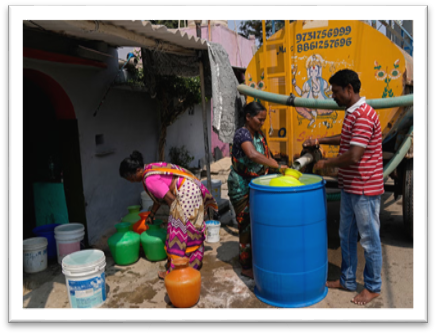- Courses
- GS Full Course 1 Year
- GS Full Course 2 Year
- GS Full Course 3 Year
- GS Full Course Till Selection
- Answer Alpha: Mains 2025 Mentorship
- MEP (Mains Enrichment Programme) Data, Facts
- Essay Target – 150+ Marks
- Online Program
- GS Recorded Course
- Polity
- Geography
- Economy
- Ancient, Medieval and Art & Culture AMAC
- Modern India, Post Independence & World History
- Environment
- Governance
- Science & Technology
- International Relations and Internal Security
- Disaster Management
- Ethics
- NCERT Current Affairs
- Indian Society and Social Issue
- NCERT- Science and Technology
- NCERT - Geography
- NCERT - Ancient History
- NCERT- World History
- NCERT Modern History
- CSAT
- 5 LAYERED ARJUNA Mentorship
- Public Administration Optional
- ABOUT US
- OUR TOPPERS
- TEST SERIES
- FREE STUDY MATERIAL
- VIDEOS
- CONTACT US
WHAT HAS CAUSED THE WATER CRISIS IN BENGALURU, NEIGHBORING AREAS
WHAT HAS CAUSED THE WATER CRISIS IN BENGALURU, NEIGHBORING AREAS
21-03-2024
While Bengaluru is receiving the majority of the attention, many regions of Karnataka and neighboring states are experiencing water scarcity. The causes can be attributed to the previous monsoon season as well as the characteristics of aquifers in the region
- Acute drinking water crisis in Bengaluru has been creating international headlines for the past few days.
- Karnataka Chief Minister Siddaramaiah said Bengaluru was facing a shortage of 500 million liters of water every day, about a fifth of the city's daily total demand.
- CM said arrangements were being made for additional supplies for Bengaluru.
- The shortage of water is not restricted to Bengaluru, nor is it only a drinking water problem.
- The entire state of Karnataka, as also the adjoining areas of Telangana and Maharashtra, are facing water scarcity.
- Much of this has to do with the below normal rainfall in the area during the last year and the nature of the underground aquifers in the area.
Why the shortage
- Karnataka received rainfall that was 18 per cent below normal during last year’s monsoon, the least since 2015.
- Even the post-monsoon period did not bring much rain to the state.
- Karnataka receives its annual rainfall during the monsoon, which fills up reservoirs and recharges aquifers.
- Aquifers in south India are rocky, hold less water, and get recharged quickly, making them unable to sustain for long during a prolonged dry spell.
- Aquifers in north India have a much better capacity to hold water.
- North Indian aquifers, once full, can hold enough water to sustain demand for a couple of years.
Bengaluru and neighboring areas have been facing water scarcity due to a number of factors, including:
| 1. Climate change | 2. Uncontrolled urbanization |
| 3. Lake degradation | 4. Disruptions to groundwater systems |
| 5. Seasonal rainfall variations | 6. Lower-than-normal rainfall |
| 7. Nature of underground aquifers | 8. Lack of widespread water utility services |
| 9. Non-implementation of government-rolled out water schemes | 10. High dependency on rainwater |
| 11. Encroachment into natural water bodies | 12. Overexploitation of groundwater |
| 13. Depleting water levels in borewells | 14. Localized distribution network problem |
| 15. Failed Monsoon | 16. Decades of unplanned and unregulated growth |
| 17. Rapid erosion of green cover | 18. Overexploitation of natural resources |
| 19. Concretization | 20. Corruption |
Falling reservoir levels
- Low rainfall has resulted in low water levels in reservoirs.
- Karnataka reservoirs are currently holding water at only 26% of their full capacity, which is 10 percentage points lower than expected.
- Only 6.5 billion cubic meters of water is currently available in Karnataka's reservoirs, compared to the expected 8.8 billion cubic meters.
- This is depleting steadily, with 7.78 billion cubic meters of water in the reservoirs a month earlier.
- Other states in south India, particularly Telangana, are also facing the same problem of below-normal water levels in reservoirs.
- Karnataka's reservoirs are depleting faster than those of neighboring states due to different demands.
- Roughly half of Bengaluru gets its drinking water through piped supply, while the other half mostly uses groundwater.
- Areas with piped supply are not facing much disruption as the water comes from reservoirs.
- In situations with scanty rainfall and low reservoir levels, governments prioritize drinking water needs, especially in urban areas.
- The drinking water problem seems most acute in parts of Bengaluru that are dependent on groundwater.
- As summer arrives, the state might face an even bigger water crisis due to increased demand from households, industries, agriculture, and hydropower sectors.
- This is likely to continue until the monsoon rains arrive, hopefully in the first or second week of June.
Dealing with water shortage in Bengaluru, elsewhere
- Long-term structural issues affecting water availability in Bengaluru include unregulated construction, systematic destruction of lakes, hindrances to the natural underground flow of water, and climate change.
- The immediate trigger for the ongoing water shortage is the seasonal fluctuation in rainfall and the state's inability to create capacities to deal with these variabilities.
- Rural parts of the state are likely facing an even greater water shortage than Bengaluru.
- India has not built capacities to deal with multiple-year droughts.
- Analysis of the last 800 years of data shows that the probability of two or three continuous years of drought at the state level is very high.
- It is necessary to put value on water and incentivize low or optimum consumption while discouraging wastage.
- The use of ground water through household pumps needs to be discouraged and minimized.
Must Check: Best IAS Coaching In Delhi



